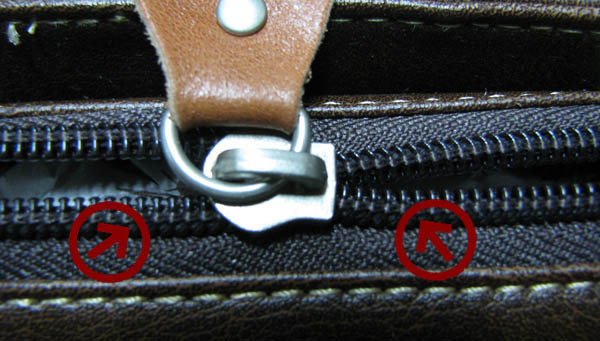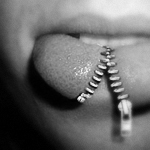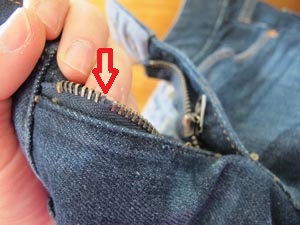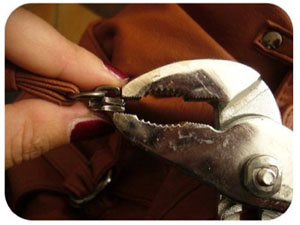Expose
Zipper problems


Learn more about zippers
Don’t you hate it when your zipper conks out on you leaving you with a bag that cannot be zipped up? Zippers play a critical role in your bag’s construction and they should be durable, lightweight, colour coordinated and even waterproof if needed.
Size
There are many zipper sizes available but sizes #5 through #8 are most suitable for main compartments. You’ll be happy to know that Feb 29 uses at least #5 for our main compartments to maintain durability.
Tooth Type

Coil (aka nylon zipper) - Coil teeth are plastic, sewn onto the zipper cloth. Although most are now made of polyester, there were formerly made of nylon and are still often referred to as nylon zippers. They are smoother to open, very flexible, easier to sew with and doesn’t trap inner linings as much as metal teeth. They are however prone to problems with dirt and abrasion on the tiny threads holding onto the plastic coils.

Molded Plastic Tooth (aka plastic chain) - These have individually injected molded teeth, fused directly onto the tape of the zipper. Resins are used to manufacture these plastic chain and they are usually stronger than coil type zippers. They also stand up to dirt and sand much better than coil zippers. These zippers are great for outdoor adventures.

Metal Tooth (aka metal chain) – These are the oldest types of zippers and they are usually made from flat metal wire. They certainly look better but they tend to corrode and fall apart with time and abuse. They also have a great tendency of catching inner lining, either tearing a hole in them or the tooth breaking off the cloth tape, which will mean a fairly expensive repair. Typically, Steel tooth tend to rust, aluminium tend to oxidize and making your bag look jaded.
Zipper Maintenance
Like most types of equipment, zippers require a bit of maintenance every now and then to prolong its lifespan.
Zippers should out survive your bag if maintained and used appropriately. Forcing zippers and overstuffing of your bag will damage both your zipper and slider. I.e. Zippers opening up, stuck sliders and etc
Inspect your zipper and sliders every week. Dirt should be removed and you may want to coat your zipper with silicone waterproofing, Teflon spray or candle wax will add some protection to sliders and help lubricate them.

Watch for misaligned zipper teeth. Occasionally, the zippers will misalign when forcing the slider to close the zipper too fast and/or when zipping around a bend in the zipper. This can become a serious problem since this part of the zipper closure is weaker and can easily come apart later.
Metal sliders often are made of metal alloy i.e. steel are prone to corrosion, especially when exposed to salt water or humid environments. If your zippers come into contact with “salt agents”, they should be rinsed off with fresh water and dried out as soon as possible.

Opened or Jammed Zippers
Zipper sliders can get caught on stuffs in your bag, cloth lining from your bag, dirt/debris or even the cloth zipper edges themselves. If you zipper becomes stuck, slide your finger below the slider and try to dislodge the trapped object. Forcibly yanking on a zipper slider will result in damage to the slider or zipper itself.
Once freed up, inspect the area to see what might have caused the jam. If fabric from the pack or zipper is a culprit and this becomes a regular occurrence, you may need to iron or stitch the lining to prevent future jams.
Worn Sliders /zip heads
Metal slider can open up over time or just get worn out with hard use and exposure to dirt and sand. Once a slider becomes parted or worn enough, the zipper will misalign more and more and eventually part somewhere behind the slider.

To temporarily mend a worn slider, first make sure the zipper behind the end of the slider is closed and properly aligned by gently sliding it back and forth until everything is lined up. Then use a pair of needle nose pliers to gently press back end where the zipper should be lock together one corner at a time. Test your slider and repeat until it is working properly.
It is important not to force the zipper slider closed to the point that it no longer slides. Should this happen, you might be able to pry it loose with a flat tip screwdriver or you may need to remove and replace the slider all together.
Slider/ziphead Replacement
If you can't repair a slider by reshaping with pliers, it may be time to replace the slider altogether. Feb 29 usually charge a very small fee for replacing them for our customers.

Replacing or Upgrading a Zipper
Zippers can wear out or get damaged to the point that they need to be replaced. This is a very laborious task and usually takes a while longer to replace. Charges will be much higher due to the tedious work of sewing the new zipper using the original holes caused by the previous sewing.



